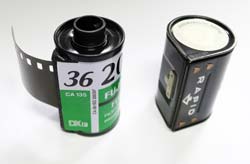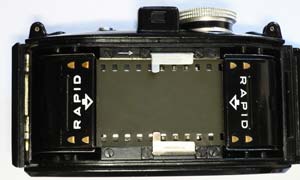Loading Cameras that use Karat or Rapid cassettes
Karat/Rapid Cassettes

Karat cassettes were used by Agfa from the mid 1930s in their Agfa Karat series of cameras. They were used by cameras with manual exposure. The cassettes were revived as Agfa's Rapid film system in 1964 to rival Kodak's 126 film. The Rapid system had the added capability of setting the camera's exposure-metering mechanism (if any) to the proper film speed automatically. The Karat and Rapid cassettes are approximately the same size and shape. However, the Karat/Rapid cassettes are slightly shorter in height than standard 135 cassettes and have no central spindle. The advantage over the 35mm cassette was that it did not have to be threaded onto a take-up spool. The new full cassette is placed into the left hand film chamber with a leader protruding which is locked into the film gate. The camera automatically guides the leader into the velvet light-trap of the takeup cassette. The film does not need to be rewound.

The Karat and Rapid cassettes are no longer produced. It is possible to load a Rapid cassette with 35mm film in a dark room or changing bag. This cassette can only handle about 12 frames of film. Do not try to pack more frames in. You will only need enough film for 12 exposures plus some film for a leader(80mm) and some film to allow the mechanism to push the last frame into the cassette(50mm). About 60cm should be enough. As 36 exposure 35mm film is about 155cm long, you should be able to fill the Rapid cassette 2 times from one cassette of 35mm film.
If the camera you are using is automatic and relies on the Rapid coding system to set exposure, then you must match the code on the cassette to the film speed (A=25, B=32, C=40, D=50, E=64, F=80, G=100, H=125, I=160 K=200, L=250, M=320, N=400).
Prepare the Rapid Cassette

You will need:-
- A cassette of 35mm film
- A Rapid cassette
- Scissors.
- A measuring stick or something exactly 60cm long.
- Some soft gloves
- Dark room or changing bag.
Prepare the 35mm film by cutting off the leader of the film to give a straight edge. Do not cut through the sprocket holes, cut between them. Then just nip the ends off the corners to help feed it into the Rapid cassette. Put the required items into the changing bag. Inside the changing bag, pull out 60cm of film using the 60cm measuring stick (or 2 x 30cm) as a guide. Cut the film from the 35mm cassette. Now, ensuring that the Rapid cassette is the right way so that the film will curl up inside, use the gloves to push the film into the Rapid cassette, nipped end in first, leaving 1cm free. Open the bag. Take out the Rapid cassette, straighten up the end of the film (between the sprocket holes) and nip the corners off the film.
Using the Cassettes

Place the full cassette in the left hand compartment of the camera. Pull out sufficient film to go over the gate and push it into the receiving Rapid cassette in the right hand compartment. Push the film into the receiving cassette by about 1-2 cm. Try not to pull more that the required amount of film from the full cassette. Close the film door.
Turn the exposure counter to 'A'. Advance the film until the exposure counter shows No. 1. Your camera is now ready for use. When 12 frames have been exposed, wind on until the 'A' appears in the exposure counter again. This should ensure that the remaining film is pushed into the right hand cassette. Remove the Rapid cassette from the right hand compartment and take to the lab for development.
Using Rapid Cameras without the Cassettes
If you don't have Rapid film cassettes then you can put the 35mm film directly into the camera.
In a dark room or using a changing bag, measure out 60cm of film and roll it into the left hand compartment of your camera. Put the film under the film clips with about 6cm of film rolled up in the right hand compartment. Close the camera and remove from the dark. You can now set the exposure counter to No. 1.
After 12 exposures the film can be unloaded into a black canister in a dark room or changing bag. Make sure you tell the lab that the canister contains unprotected film.

Find out more about the Agfa Karat camera here:- The Agfa Karat